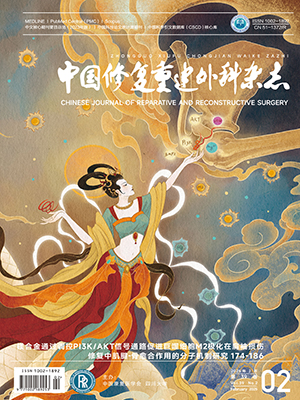| 1. |
Niu X, Zhang Q, Hao L, et al. Giant cell tumor of the extremity:retrospective analysis of 621 Chinese patients from one institution. J Bone Joint Surg (Am), 2012, 94(5):461-467.
|
| 2. |
Mendenhall WM, Zlotecki RA, Scarborough MT, et al. Giant cell tumor of bone. Am J Clin Oncol, 2006, 29(1):96-99.
|
| 3. |
Asavamongkolkul A, Eamsobhana P, Waikakul S, et al. The outcomes of treatment of giant cell tumor of bone around the knee. J Med Assoc Thai, 2012, 95 Suppl 9:S122-S128.
|
| 4. |
Errani C, Ruggieri P, Asenzio MA, et al. Giant cell tumor of the extremity: A review of 349 cases from a single institution. Cancer Treat Rev, 2010, 36(1):1-7.
|
| 5. |
Klenke FM, Wenger DE, Inwards CY, et al. Giant cell tumor of bone: risk factors for recurrence. Cl in Orthop Relat Res, 2011, 469(2):591-599.
|
| 6. |
Kivioja AH, Blomqvist C, Hietaniemi K, et al. Cement is recommended in intralesional surgery of giant cell tumors:a Scandinavian Sarcoma Group study of 294 patients followed for a median time of 5 years. Acta Orthop, 2008, 79(1):86-93.
|
| 7. |
Becker WT, Dohle J, Bernd L, et al. Local recurrence of giant cell tumor of bone after intralesional treatment with and without adjuvant therapy. J Bone Joint Surg (Am), 2008, 90(5):1060-1067.
|
| 8. |
Radev BR, Kase JA, Askew MJ, et al. Potential for thermal damage to articular cartilage by PMMA reconstruction of a bone cavity following tumor excision:A finite element study. J Biomech, 2009, 42(8):1120-1126.
|
| 9. |
Gortzak Y, Kandel R, Deheshi B, et al. The efficacy of chemical adjuvants on giant-cell tumour of bone. An in vitro study. J Bone Joint Surg (Br), 2010, 92(10):1475-1479.
|
| 10. |
Chen TH, Su YP, Chen WM. Giant cell tumors of the knee:subchondral bone integrity affects the outcome. Int Orthop, 2005, 29(1):30-34.
|
| 11. |
Enneking WF, Dunham W, Gebhardt MC, et al. A system for the functional evaluation of reconstructive procedures after surgical treatment of tumors of the musculoskeletal system. Clin Orthop Relat Res, 1993, (286):241-246.
|
| 12. |
Aboulafia AJ, Rosenbaum DH, Sicard-Rosenbaum L, et al. Treatment of large subchondral tumors of the knee with cryosurgery and composite reconstruction. Clin Orthop Relat Res, 1994, (307):189-199.
|
| 13. |
van Saase JL, van Romunde LK, Cats A, et al. Epidemiology of osteoarthritis: Zoetermeer survey. Comparison of radiological osteoarthritis in a Dutch population with that in 10 other populations. Ann Rheum Dis, 1989, 48(4):271-280.
|
| 14. |
Campanacci M, Capanna R, Fabbri N, et al. Curettage of giant cell tumor of bone. Reconstruction with subchondral grafts and cement. Chir Organi Mov, 1990, 75(1 Suppl):212-213.
|
| 15. |
Abdelrahman M, Bassiony AA, Shalaby H, et al. Cryosurgery and impaction subchondral bone graft for the treatment of giant cell tumor around the knee. HSS J, 2009, 5(2):123-128.
|
| 16. |
Canale ST, Besty J. 坎贝尔骨科手术学. 11版. 卢世璧, 译. 北京:人民军医出版社:710-716.
|
| 17. |
von Steyern FV, Kristiansson I, Jonsson K, et al. Giant-cell tumour of the knee:the condition of the cartilage after treatment by curettage and cementing. J Bone Joint Surg (Br), 2007, 89(3):361-365.
|
| 18. |
Fraquet N, Faizon G, Rosset P, et al. Long bones giant cells tumors: treatment by curretage and cavity filling cementation. Orthop Traumatol Surg Res, 2009, 95(6):402-406.
|
| 19. |
Frassica FJ, Gorski JP, Pritchard DJ, et al. A comparative analysis of subchondral replacement with polymethylmethacrylate or autogenous bone grafts in dogs. Clin Orthop Relat Res, 1993, (293):378-390.
|
| 20. |
Wada T, Kaya M, Nagoya S, et al. Complications associated with bone cementing for the treatment of giant cell tumors of bone. J Orthop Sci, 2002, 7(2):194-198.
|
| 21. |
Tejwani SG, Hame SL, Eckardt JJ. Subchondral giant-cell tumor of the proximal tibia:arthroscopic treatment for accelerated articular cartilage and meniscal degeneration in two patients. Arthroscopy, 2004, 20(6):644-649.
|
| 22. |
Gaston CL, Bhumbra R, Watanuki M, et al. Does the addition of cement improve the rate of local recurrence after curettage of giant cell tumours in bone? J Bone Joint Surg (Br), 2011, 93(12):1665-1669.
|
| 23. |
Suzuki Y, Nishida Y, Yamada Y, et al. Re-operation results in osteoarthritic change of knee joints in patients with giant cell tumor of bone. Knee, 2007, 14(5):369-374.
|




